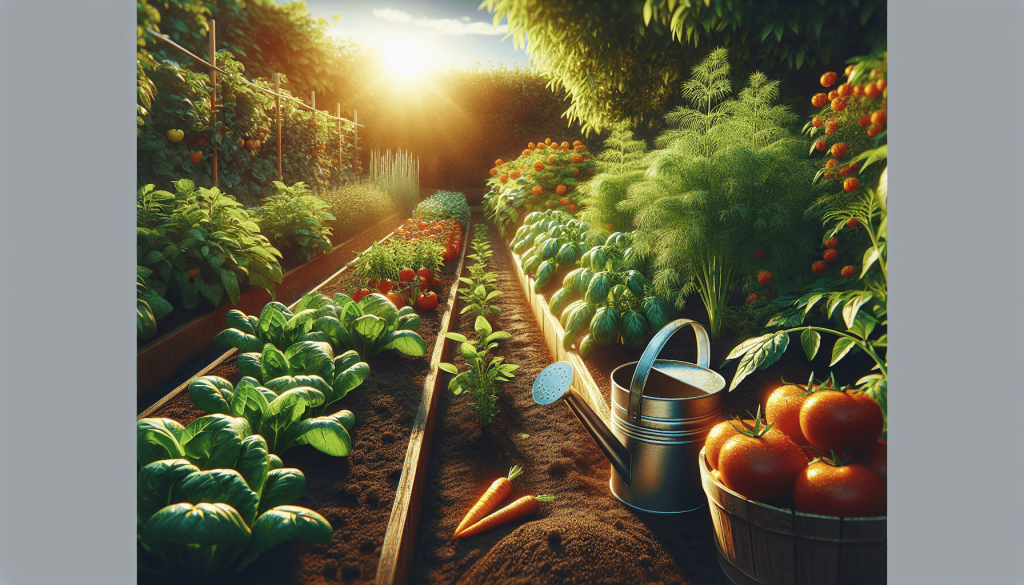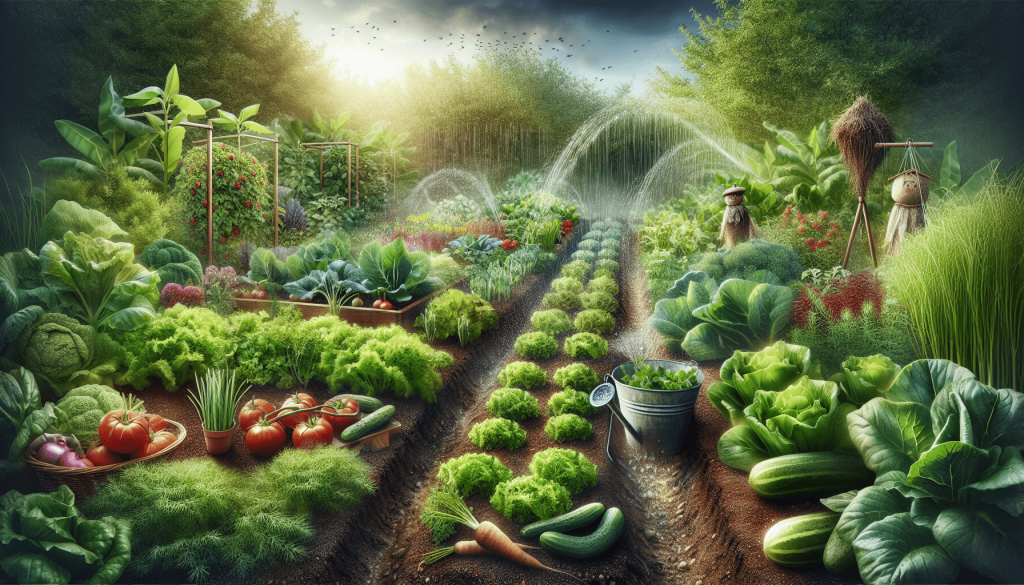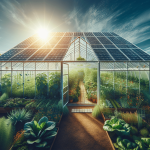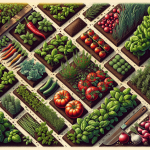This post may contain affiliate links. As an Amazon Associate, we may earn commissions from qualifying purchases.
If you’ve ever dreamed of cultivating your own lush and bountiful vegetable garden, but don’t know where to start, then look no further. In this article, we will guide you on the journey towards creating a thriving and successful vegetable garden, even if you have little to no gardening experience. From selecting the right location to choosing the perfect vegetables for your climate, we’ll provide you with all the essential tips and tricks to turn your backyard into a green haven of deliciousness. So grab your gardening gloves and get ready to dig into the wonderful world of vegetable gardening!

Choosing the right location
Consider sunlight exposure
When choosing a location for your vegetable garden, one of the most important factors to consider is sunlight exposure. Most vegetables require at least six to eight hours of direct sunlight each day to thrive. Take note of the areas in your yard that receive the most sunlight and choose a spot that meets this requirement.
Assess soil quality
The quality of the soil in your garden can have a significant impact on the growth and productivity of your vegetables. Before planting, it is essential to assess the soil to ensure it has the right composition and pH level. You can use a soil testing kit or send a sample to a lab for analysis. This information will help you determine what amendments, such as adding compost or adjusting the pH, are needed to create optimal growing conditions.
Ensure proper drainage
Proper drainage is crucial for the health of your plants. If your chosen location has poor drainage, it can lead to waterlogged soil, which can cause root rot and other issues. To ensure proper drainage, consider the natural slope of the land or add raised beds to improve water flow. This will prevent your plants from sitting in standing water and promote healthy root development.
Planning your garden layout
Decide the garden size
The size of your vegetable garden will depend on your available space and the amount of time and effort you can dedicate to its maintenance. Start with a modest size that you can comfortably manage and expand it as you gain experience and confidence. Remember to leave enough space between beds or rows for easy access and maintenance.
Plan for crop rotation
Crop rotation is an essential practice in vegetable gardening that helps prevent diseases and pests from building up in the soil. By rotating your crops each year, you disrupt the life cycle of pests and diseases that may be specific to certain plants. Plan your garden layout in a way that allows you to rotate crops annually, keeping track of which plants were grown in each area and avoiding planting the same family of crops in the same spot for consecutive years.
Consider companion planting
Companion planting is the practice of planting certain crops together to promote growth, repel pests, and maximize space utilization. Some plant combinations work symbiotically, benefiting each other in terms of nutrient uptake and pest control. For example, planting marigolds alongside tomato plants can deter pests like nematodes, while planting radishes around lettuce can help deter leaf-eating insects. Consider companion planting when planning your garden layout to create a healthier and more productive vegetable garden.
Preparing the soil
Clear the area of debris
Before you start preparing the soil, it is essential to clear the designated area of any debris, such as rocks, weeds, or grass. This ensures a clean and fresh start for your vegetable garden. Use a rake or shovel to remove any visible debris and create a blank canvas for your gardening endeavor.
Test and amend the soil
Testing the soil is a critical step in preparing your vegetable garden. It provides valuable information about the soil’s pH level and nutrient composition. Based on the test results, you can make amendments to improve the overall fertility and health of the soil. Common amendments include adding compost or well-rotted manure to increase organic matter, adjusting the pH level if necessary, and incorporating additional minerals or nutrients, such as nitrogen, phosphorus, and potassium.
Add organic matter
To improve the structure and nutrient content of your soil, adding organic matter is essential. Organic matter, such as compost, enriches the soil, enhances water retention, and promotes beneficial microbial activity. Spread a generous layer of compost over the prepared soil and gently work it into the top few inches. This will provide a nutrient-rich environment for your vegetables to thrive.
Selecting vegetable varieties
Choose vegetables suitable for your climate
When selecting vegetable varieties, it is crucial to consider your climate and growing conditions. Some vegetables tolerate heat and drought better, while others thrive in cooler temperatures. Research the recommended varieties for your specific region or seek advice from local gardening experts to ensure you choose vegetables that are well-suited for your climate. By selecting appropriate varieties, you increase your chances of a successful harvest.
Consider your family’s preferences
Another important factor to consider when choosing vegetable varieties is your family’s preferences. Consider the vegetables that you and your family enjoy eating the most. By growing vegetables that you love, you will be more motivated to care for your garden and harvest the produce. Additionally, growing your favorite vegetables allows you to enjoy the freshest and most flavorful produce straight from your garden.
Look for disease-resistant varieties
Vegetable diseases can be a significant setback in your garden. To minimize the risk, consider choosing disease-resistant varieties. These varieties have been specifically bred or selected for their ability to withstand certain diseases or pests. Disease-resistant varieties can help prevent the spread of diseases and reduce the need for chemical interventions. Look for labels or descriptions that indicate disease resistance when selecting your vegetable varieties.

Starting from seeds or seedlings
Read seed packets or catalogs
Whether you choose to start from seeds or purchase seedlings, it is essential to read the information provided on the seed packets or catalogs. The packet or catalog will provide valuable information on planting depth, spacing requirements, days to maturity, and any specific care instructions. Understanding this information will help you properly plan and care for your vegetables throughout their growth cycle.
Start seeds indoors
Starting seeds indoors can give you a head start on the growing season and allow you to have more control over the plant’s early stages of development. Follow the instructions on the seed packet or catalog for the optimal time to start seeds indoors and provide them with proper lighting, warmth, and moisture. This method enables you to prepare healthy and robust seedlings before transplanting them into the garden.
Harden off seedlings
Before transplanting your seedlings into the outdoor garden, it is crucial to gradually expose them to the outdoor conditions. This process, known as hardening off, helps the seedlings adjust to the temperature, wind, and sunlight levels they will encounter in the garden. Start by placing the seedlings outdoors for short periods, gradually increasing the duration over a week or two. This gradual transition helps prevent transplant shock and gives your seedlings the best chance of survival and growth.
Planting and spacing
Follow proper planting guidelines
To ensure the success of your vegetable garden, it is essential to follow proper planting guidelines. Dig holes or trenches of appropriate depth and spacing, as recommended on the seed packets or catalogs. Correct planting depth ensures proper root development, while adequate spacing allows the plants to receive sufficient light and airflow, reducing the risk of diseases and promoting healthy growth.
Leave enough space between plants
Proper spacing between plants is crucial for their overall development and productivity. Crowded plants compete for nutrients and sunlight, which can lead to stunted growth and reduced yields. Follow the recommended spacing guidelines to give your plants enough room to grow fully and ensure optimal airflow. Proper spacing also makes it easier to access each plant for watering, weeding, and harvesting.
Consider using raised beds
If you have limited space or poor soil quality, consider utilizing raised beds for your vegetable garden. Raised beds offer several advantages, including better control over soil quality, improved drainage, and easier access for planting and maintenance. Additionally, raised beds can extend the growing season by allowing for earlier planting in the spring and better insulation during cooler months. Consider building or purchasing raised beds to optimize the productivity of your vegetable garden.
Watering and irrigating
Water deeply and infrequently
Proper watering is essential for your vegetable garden’s health and productivity. Instead of frequent shallow watering, it is beneficial to water deeply and infrequently. This encourages the plants to develop deep root systems, making them more resilient to drought conditions. Aim for about an inch of water per week, adjusting as needed based on rainfall and temperature. Additionally, watering in the morning or early afternoon allows foliage to dry before evening, reducing the risk of fungal diseases.
Consider using soaker hoses or drip irrigation
To maximize water efficiency and minimize evaporation, consider using soaker hoses or drip irrigation systems in your vegetable garden. These methods ensure that water is delivered directly to the plant roots, reducing water waste and potential disease spread. Soaker hoses or drip irrigation can be placed along the base of the plants and connected to a timer or regulated faucet, providing consistent and targeted moisture to your vegetables.
Mulch to retain moisture
Mulching is a beneficial practice that helps retain soil moisture, suppress weeds, and regulate soil temperature. Consider applying a layer of organic mulch, such as straw, wood chips, or compost, around your vegetable plants. Mulch acts as a protective layer, preventing water evaporation from the soil surface and reducing weed competition. Additionally, as the organic mulch breaks down, it adds valuable nutrients to the soil, further enhancing the growth of your vegetables.
Weeding and pest control
Regularly remove weeds
Weeds can compete with your vegetable plants for nutrients, water, and sunlight. Regularly removing weeds is crucial for maintaining the health and productivity of your garden. Take time each week to remove any visible weeds, either by hand-pulling or using garden tools. Minimizing weed growth also helps deter pests and diseases that may be attracted to weed-infested areas. Stay vigilant and stay on top of weed control to keep your vegetable garden thriving.
Use natural pest control methods
Controlling pests in your vegetable garden is important for preventing damage to your plants and ensuring a successful harvest. Consider using natural pest control methods, such as companion planting, beneficial insects, or homemade organic sprays. For example, planting marigolds or nasturtiums can help deter aphids, while introducing ladybugs or praying mantises can control pests like caterpillars and aphids. Incorporating these natural pest control methods reduces the reliance on chemical pesticides, promoting a healthier and environmentally friendly garden.
Monitor plants for signs of pests
Regular monitoring of your plants is crucial for identifying and addressing pest problems early. Inspect the leaves, stems, and fruits for any signs of pest infestation, such as chewed leaves, holes, or webbing. Early detection allows for prompt intervention, whether through manual removal, using organic pest control methods, or seeking advice from local gardening resources. By monitoring your plants closely, you can take proactive measures to prevent significant pest damage and maintain a productive garden.
Fertilizing
Use organic fertilizers
Fertilizing your vegetable garden is important for providing essential nutrients necessary for healthy plant growth and optimum yields. When choosing fertilizers, opt for organic options to promote long-term soil health and minimize environmental impact. Organic fertilizers, such as compost, well-rotted manure, or bone meal, slowly release nutrients into the soil, ensuring a steady and balanced supply for your plants. Additionally, organic fertilizers improve soil structure and encourage beneficial microbial activity, creating a thriving ecosystem in your garden.
Follow recommended application rates
Too much or too little fertilizer can harm your plants and negatively impact the soil. It is crucial to follow the recommended application rates provided on the fertilizer packaging or consult with local gardening experts for guidance. Over-fertilization can lead to nitrogen burn or nutrient imbalances, while under-fertilization can result in stunted growth and nutrient deficiencies. By adhering to the recommended application rates, you provide your plants with the nutrients they need without causing harm or wasting resources.
Apply fertilizers at the right time
Timing is essential when it comes to applying fertilizers in your vegetable garden. Different stages of plant growth have varying nutrient requirements. Generally, it is best to apply fertilizers before planting or during the early growth stages to ensure the nutrients are readily available to the developing plants. Additionally, consider side-dressing or top-dressing your vegetables with compost or well-rotted manure throughout the growing season to provide an extra boost of nutrients. Regular and timely fertilization contributes to the overall health and productivity of your vegetable garden.
Maintaining and harvesting
Prune plants when necessary
Proper pruning is crucial for maintaining the health, shape, and productivity of your vegetable plants. Remove any damaged or diseased branches, as well as any crowded or crossing stems that impede airflow and sunlight penetration. Pruning also encourages the development of strong and productive branches and allows you to shape your plants as desired. Regularly check your vegetables for any pruning needs and follow proper pruning techniques to ensure the best outcomes for your garden.
Support tall plants with stakes or trellises
Tall or vining plants, such as tomatoes, cucumbers, or beans, often require support to prevent them from sprawling on the ground and risking damage or disease susceptibility. Use stakes, cages, or trellises to provide support and promote vertical growth for these plants. This not only keeps the fruits off the ground, reducing the risk of rot or pest infestation, but also maximizes space utilization in your garden.
Harvest vegetables at peak ripeness
One of the most rewarding parts of vegetable gardening is harvesting your home-grown produce. To enjoy the best flavor and nutritional value, it is essential to harvest your vegetables at their peak ripeness. Each vegetable has different signs of ripeness, such as color, size, or texture. Refer to seed packets or gardening resources to learn the specific indicators for each vegetable you are growing. Harvesting at the right time ensures the best taste and quality, allowing you to savor the fruits of your labor in your own kitchen.
Creating a successful vegetable garden involves careful planning, proper soil preparation, appropriate variety selection, and diligent care throughout the growing season. By following these comprehensive guidelines, you can establish a thriving vegetable garden that provides an abundance of fresh and delicious produce for you and your family to enjoy. Happy gardening!








